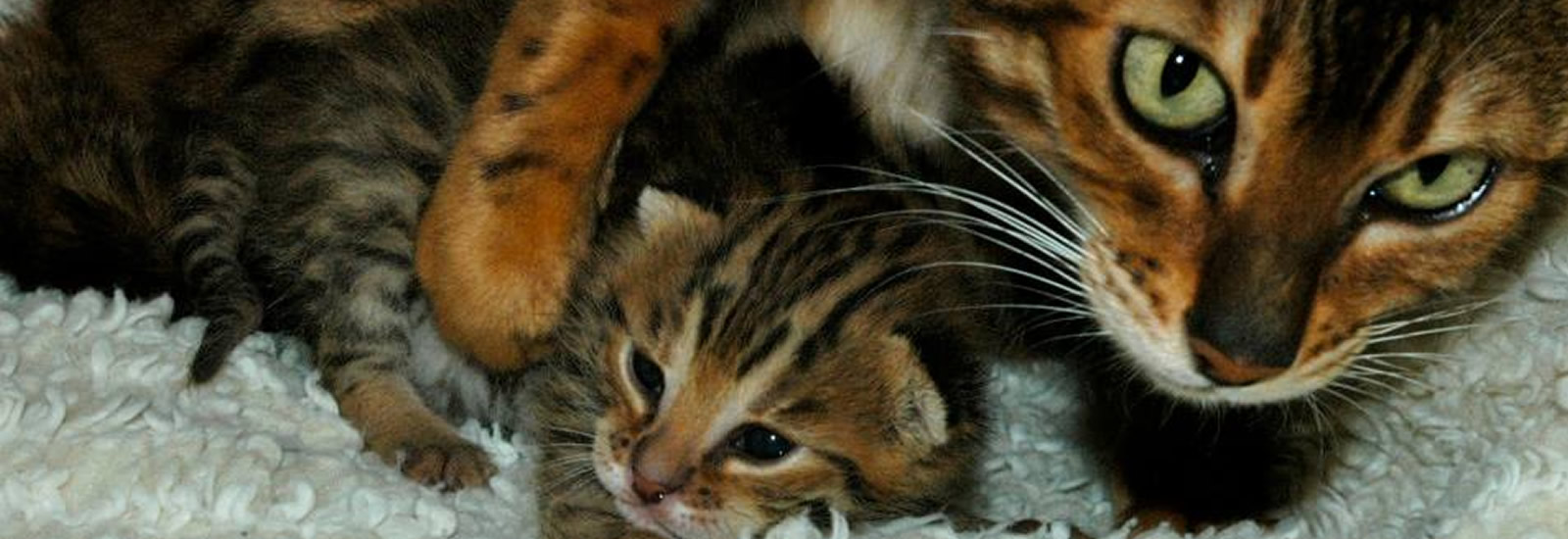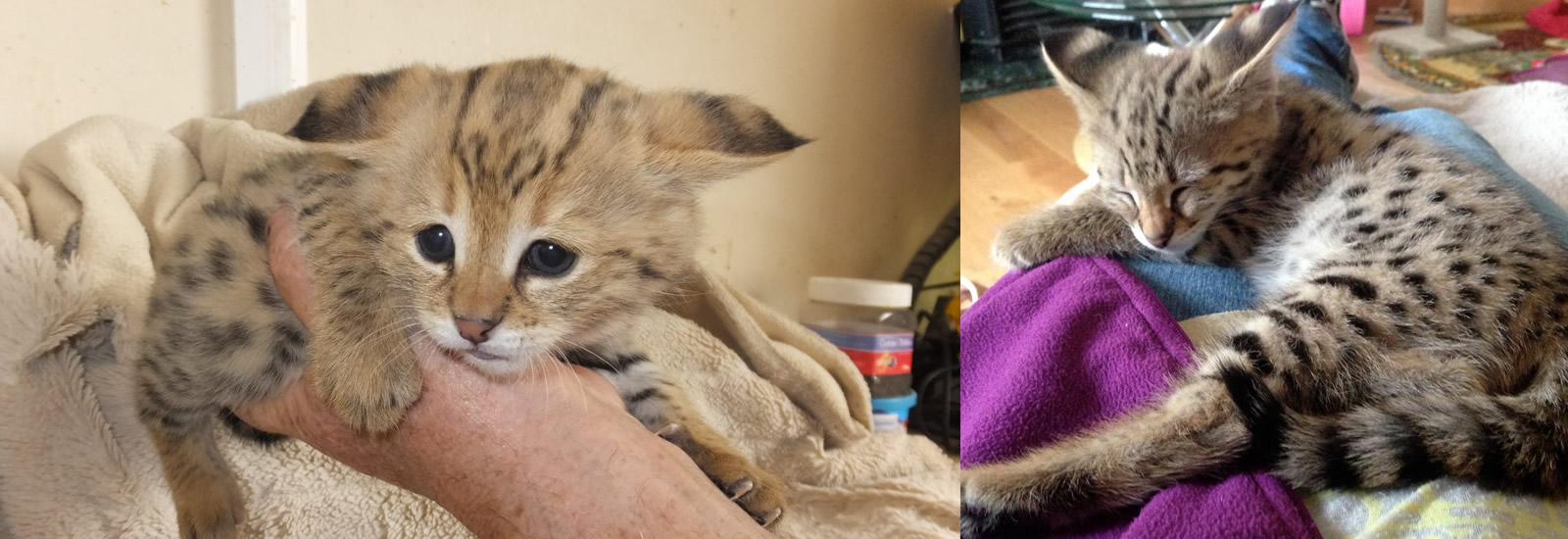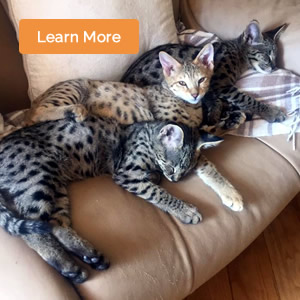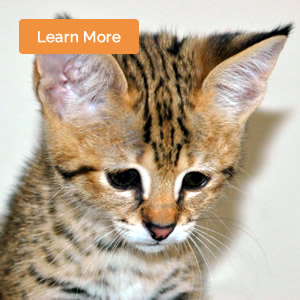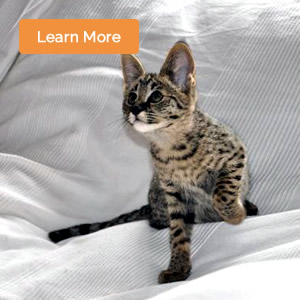Buying,
Training and Caring
for Bengal Cats
By C. Esmond Gay - Sarez Bengals - 2004
Choosing which type of pedigree cat to share one’s life with can be a daunting task; they’re all so different, and each beautiful and amazing in their own right… some are energetic and vivacious, whilst others are calm and quiet. But if a person decides upon a Bengal, then they get many wondrous traits in that animal. These cats are unique, and it’s guaranteed that their owners will quickly grow to adore them. Bengals are entertaining, funny and charming, and they’ll forever bestow undying love and devotion upon their human family. And in return, these cats should be looked after in the very special way they deserve.
Characteristics of the Bengal Cat
Sarez
Pharaoh (F2 Male) - Circa October 1995 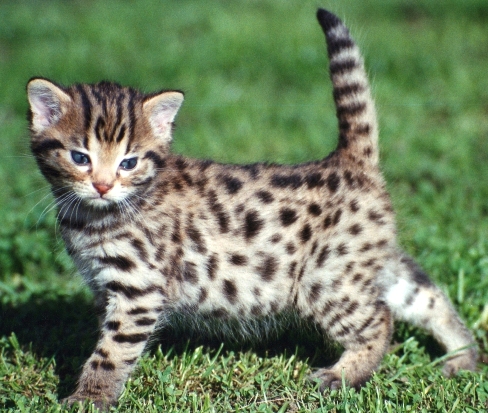
Some Bengals can be headstrong as to their likes and dislikes, for example, most love being cuddled, whilst others have a preference for shoulders - and all like heights! So their owners should treat them to a tall carpeted tree with lots of platforms and a soft perch on top, which along with a soft knee, will become their lifetime favourite spot. And watching them leap from pillar to post as they replicate what wild leopard cats do in the jungles of Asia, will brighten up the dreariest of days, and their have owners in hysterics!
Bengals are a talkative breed and like to chatter away to members of their human family, especially if the listener is equally as vocal and expressive as they! And these cats have other idiosyncrasies that set them apart from other breeds - most enjoy water and will play for long periods in a bathroom sink with the tap slightly running. Some of ours even get into the bath with us and then unashamedly shake themselves dry all over the bathroom!
Finding a Bengal Kitten
 Once
would-be owners have decided upon this breed, they must remember that
the chosen kitten will be a part of their family for many years and
therefore, effort must be put into the search because if a mistake is
made, it will be hard to rectify later. Interested parties should
look in cat magazines and on the internet, and then draw up a short
list of good breeders - but they should beware of those who think
that breeding Bengals is “easy money”, and that they can
replicate what good breeders do, but on the cheap. They
can’t!
Once
would-be owners have decided upon this breed, they must remember that
the chosen kitten will be a part of their family for many years and
therefore, effort must be put into the search because if a mistake is
made, it will be hard to rectify later. Interested parties should
look in cat magazines and on the internet, and then draw up a short
list of good breeders - but they should beware of those who think
that breeding Bengals is “easy money”, and that they can
replicate what good breeders do, but on the cheap. They
can’t!
Silky
& Her SBT Kittens Inc. Advent Gold & Lord Fonterloroy -
January 1995
The prospective owners then need to decide what type of Bengal appeals to them the most as there are a number of different generations, some closer to their wild forebears than others, and there are also a variety of colours. Both of these choices are down to personal preference and so it’s a good idea to look at photos in books and magazines and read articles. And if uncertainty persists, they should visit a number of breeders who sounded most pleasant on the phone, and who have a variety of colours and generations.
When there, the would-be owners must ask if they can look around the catteries; they should check the hygiene and also look at the adults, especially the parents of the kittens - they will give an idea of the quality of the babies, their future appearance and their characters. And if the visitors are not invited to do these things, then they should make an excuse to leave as there’s a reason why the breeder won’t allow guests to look around - maybe dirty pens, poorly adults or other issues that necessitate such secrecy.
When invited inside, the interested parties should inspect the pedigrees and look out for inbreeding, which some call line breeding, but which I call incest and am against, except in exceptional circumstances. Those who want to buy a healthy kitten shouldn’t be afraid to walk away from close matings such as brother to sister because, even though the good traits of each parent can be magnified in their offspring, so are all the bad traits, including deformities, genetic abnormalities and inherited diseases.
And no one should buy the first cheap kitten they see! A buyer gets what they pay for, and so should purchase the best available in their budget. Calculating the purchase price of the kitten over a 20 year period, helps to justify the outlay and makes him feel a little cheaper!
Sarez
Tigger (F1 Male) - Circa November 2000 Finally,
the prospective owners should bear in mind that as with other
occupations in life, the Bengal fancy has its share of gossipers;
even breeders who claim to be close friends can criticise one another
just to procure a sale. They should also be aware that if one breeder
is particularly successful, then this in itself may make some rivals
irate. Only a visit to such breeders will enable the buyer to see
what they’re truly like - and
only then judge them!
Finally,
the prospective owners should bear in mind that as with other
occupations in life, the Bengal fancy has its share of gossipers;
even breeders who claim to be close friends can criticise one another
just to procure a sale. They should also be aware that if one breeder
is particularly successful, then this in itself may make some rivals
irate. Only a visit to such breeders will enable the buyer to see
what they’re truly like - and
only then judge them!
The following is the routine my fiancée, Sarah, and I follow when someone enquires about our kittens - it may provide ideas on what to expect, what to look for and what to ask:
Normally, interested parties contact us having seen our cats on TV or in the press, so they already have an insight into us. We speak to them at length on the phone and then send them a lot of photos and written information on the Bengal. They can digest it all in the comfort of their own home, and consider what types of kittens interest them the most. It also arms them with a great deal of knowledge on the breed prior to them even setting foot in our home, and this makes the subsequent visit easier for both them and us.
When the would-be owners arrive at our estate, we give them a 1 hour tour of our property and breeding facilities. They are taken into each enclosure and are introduced to the ancestors of the Bengal, our leopard cats, and we also show them our African leopards, ocelots and servals. We explain the plight these animals face in the wild, and we describe how we try to help via our conservation programme, and how it’s funded by our kitten sales. Then we show them all our adult Bengals and we physically point out the visual and personality differences between early generation Bengals and later generations, and they see what the kittens will look like when they’re older. The visitors also watch us interact and play with all our cats, and they can do the same should they wish.
Frostie
(SBT Female) - 2nd Half of 1994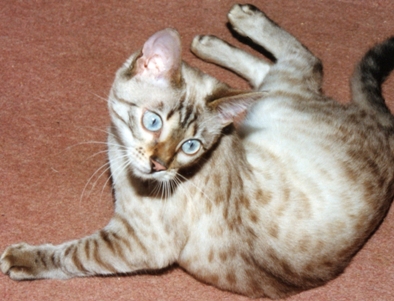 After
the tour, we invite the visitors inside and show them a large album
full of photos of almost all our cats and the kittens that we’ve
previously bred. This helps us to accurately describe the different
generations and colours, as well as other physical traits of the
Bengal. Then we describe the characters of the kittens that we have
at the time, explaining which ones are more lap cats and which are
bolder etc.
After
the tour, we invite the visitors inside and show them a large album
full of photos of almost all our cats and the kittens that we’ve
previously bred. This helps us to accurately describe the different
generations and colours, as well as other physical traits of the
Bengal. Then we describe the characters of the kittens that we have
at the time, explaining which ones are more lap cats and which are
bolder etc.
We never rush the prospective owners, and give them all the time they need. On this first day, we spend from 3 to 7 hours explaining everything that they need to know in order to make an informed decision over what type of kitten best suits them. These long discussions serve another purpose as well; they enable us to get to know the would-be owners quite well, giving us time to determine whether or not we want them to adopt one of our kittens in the first place. And we’re not afraid to turn down a home that we feel may be unsuitable - we’ve even politely refused to re-home to a couple of the celebrities who approach us. But most visitors want and are allowed to adopt, and so our extended conversations with them also helps to start building of a life long bond between us and them.
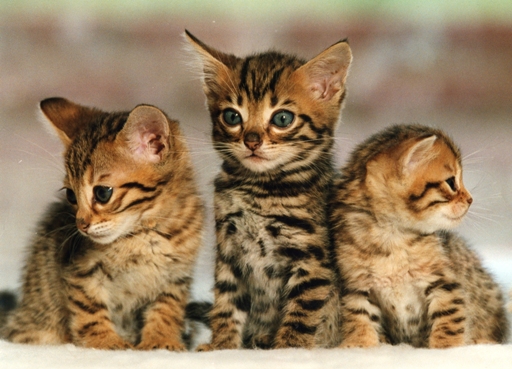 Finally,
the interested parties see a selection of kittens; ones we
think are perfect for them - no one knows their kitten’s
personalities better than the breeder! We
try to pair the home with the ideal
kitten
rather than for the visitor to be shown a litter and then taking pot
luck via a random choice - our
methods prevent them from making a wrong decision and taking a kitten
that wouldn’t be suitable for them or their lifestyle.
Finally,
the interested parties see a selection of kittens; ones we
think are perfect for them - no one knows their kitten’s
personalities better than the breeder! We
try to pair the home with the ideal
kitten
rather than for the visitor to be shown a litter and then taking pot
luck via a random choice - our
methods prevent them from making a wrong decision and taking a kitten
that wouldn’t be suitable for them or their lifestyle.
SBT
Sarez Bengal Kittens - August 1994
The First Few Days with a New Bengal Kitten
The kitten must not be younger than 12 to 13 weeks old when he’s brought home, and due to his tender age, he will feel lost for a few days and so should be confined to a small area such as a bedroom where he’ll feel safer. And if it has an ensuite, the toilet lid must be down as it’s a danger and is unhygienic as Bengals aren’t fussy where they go “fishing”!
The kitten’s owners should place his food and water dish, his bed and litter tray and perhaps a small cat scratching post in this room. After a few days, the door should be left open for short periods and the Bengal kitten will start to wander further away - this will help him to gain his bearings, but his owners must ensure that he can find his way back. It’s best for them to sit and watch their kitten, just to give him support and reassurance.
The owner should not take things for granted by expecting the kitten to guess what is required of them. For example, presuming a tiny kitten can locate a litter box in a large home is like putting a 2 year old child down in a museum and saying, “find the bathroom”. The kitten’s adopted family should try to think of all things in his life like this as it will help them to understand him and what he requires.
Leopardette
(F1) & Her F2 Kittens Inc. Kato (Sarez Allspots) - Circa Nov.
1997 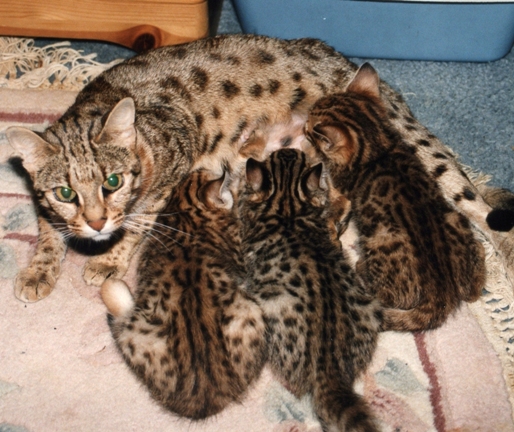
After a few excursions into the rest of the house, the Bengal will be comfortable in his new surroundings and so his owners should then move the food, water and litter trays to the main areas where they’re to live permanently. The kitten should have the freedom of the whole house and if that’s the case, then for safety, a litter tray should be on each floor.
Training a Bengal Kitten
Eager for human companionship and approval, the Bengal is a breed that can be taught many things and with the minimum of training; a firm but gentle voice should be used, and never in an angry tone. If a kitten is shown the rules of the house whilst young, no scolding will be necessary when he’s adult. For example, a firm: “No!” and a brush off the table, makes that rule clear. But due to the intelligence of the breed, their owners will find kittens respond to kindness and quickly observe what annoys them, and then avoid that action.
With a little patience and some tempting treats, a Bengal kitten can easily be taught some dog-like tricks such as sitting up, rolling over, or jumping over a stick that’s held horizontally. And their owners will find they’re natural retrievers of balls, rolled up newspaper, or cat toys - ours get excited just at the sound of paper being crumpled; their eyes start to dart around, their bodies tense and their ears prick up, knowing that a game of throw and retrieve is about to begin.
Sarez
Amber (Left) & Sarez Prince (SBTs) - Circa September 1995 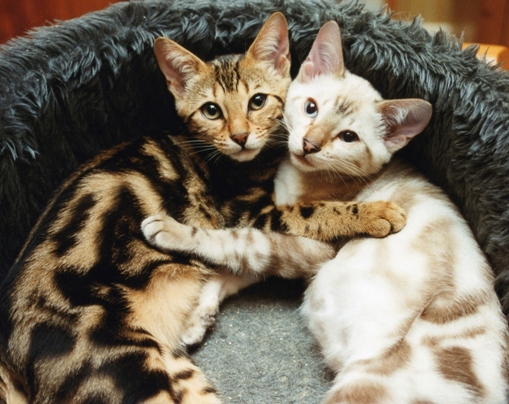
Many people think it is fine to let pedigree cats or moggies roam outside on their own. Such beliefs astonish and outrage me. Surely no one would let a 3 year old child run free outside - and so why allow a cat? It is pure ignorance! If a kitten has only ever been reared in a house, then that’s all they know. Cats do not need to go outside on their own. And if the roads don’t get them, they could be stolen or contract deadly diseases like FIP or feline AIDS. Yes, in an ideal world a cat would prefer to run free, but this isn’t a perfect world and cars are a lot bigger than they are! Sarah and I turn down any potential new owners who say they want to let the cat outside alone - because we know it may only be a matter of time before he dies due to that supposed “kindness”.
Sarez
Diamond (SBT Female) - Circa July 1995
However, once trained, a cat will behave as well as any dog; one of ours goes for 2 to 3 hour walks every day and when we reach the fields and countryside, I take the lead off him and he trots beside me or runs ahead a little bit, then he stops and waits for me to catch up. It took time to train him this well, to build up the trust required to ensure he’d never run off and to teach him my voice and whistle commands, but the results are worthwhile. I may look a little eccentric walking along with an unleashed cat galloping behind me, but I don’t care; he gets fresh air and has a nibble on the grass… and I'm content knowing he’s safe.
Continued Care of a Bengal Cat
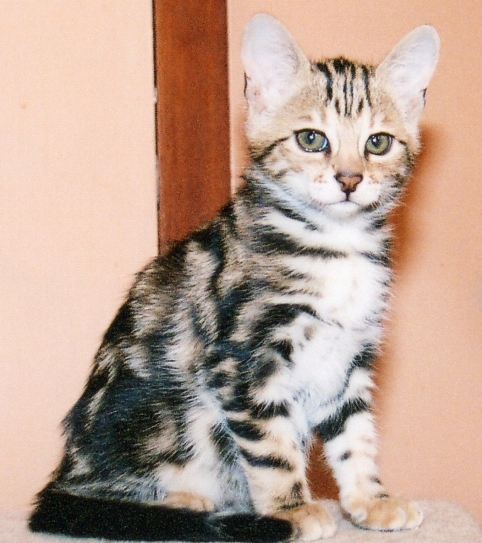 The
safest food and water dishes to use for adults are heavy stainless
steel ones so that they don’t get knocked over if the kitten
plays in it. Plastic dishes may release chemicals into the water if
it has been kept in the dish for a long time. And the water must be
changed daily.
The
safest food and water dishes to use for adults are heavy stainless
steel ones so that they don’t get knocked over if the kitten
plays in it. Plastic dishes may release chemicals into the water if
it has been kept in the dish for a long time. And the water must be
changed daily.
Bengals require little special care or grooming; a brush and comb will take out loose fur and prevent fur balls and shedding, whilst his claws should be clipped regularly as they can play rough, but no worse than any other cat. All this should be started during kittenhood.
Sarez
Alecdruimbeg (40% W/B F2) - Circa June 2004
I feel that giving one’s cats some treats is a nice thing to do for them and adds variety - imagine eating the same food every single day for 20 years! So we buy some plain fish or chicken fillets from the supermarket, cut off a small amount, cook it, and give them this titbit once a day - akin to humans enjoying a tiny bit of chocolate! It makes the cats happy and gives them something to look forward to. However such foods should never be their full diet; too much raw fish will cause vitamin E deficiency and products like canned tuna will not be good for their stomachs.
It is a myth that all cats should be fed milk. The composition of cow’s milk is different from cat’s milk and when fed to kittens or adult cats, it will frequently cause diarrhoea, resulting in dehydration, reduced activity, malnourishment and depression. Plus, adult cats are usually deficient in lactose and so cannot digest milk, making it dangerous even in small quantities.
Healthcare of a Bengal Cat
Kitten
Gay & Sarez Zeus [1st One] (75% Wild Blood F1 Male) -
24th May 2002 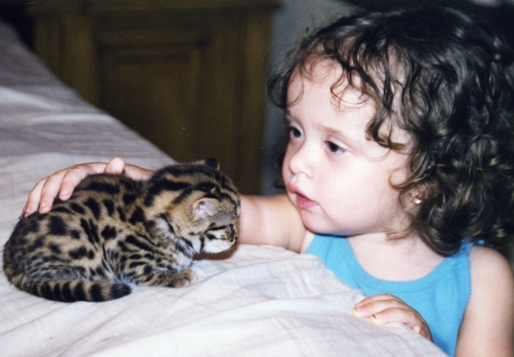
Indoor Bengals rarely become ill, but diseases can occur so their owners should be aware of indications of trouble so that the kitten can be taken to a vet if they are concerned. A healthy Bengal will be active and alert, with bright eyes and a soft lustrous coat. He will be a hearty eater, so a lack of appetite can be a sign he’s ill, as can vomiting and loose stools.
Persistent sneezing, watery eyes, and a runny nose are also indications of ill health and must be tended to. If he is listless and the third eyelid (haw) appears in the corner of his eye and remains there, something is wrong. If his coat becomes rough, with excessive shedding, this too is a sign of illness. And cross contamination should be avoided where possible and so an ill cat should be kept away from healthy ones, and the areas disinfected.
Sarez
Miss World & Her SBT Kittens + Two F2 Kittens - April 1998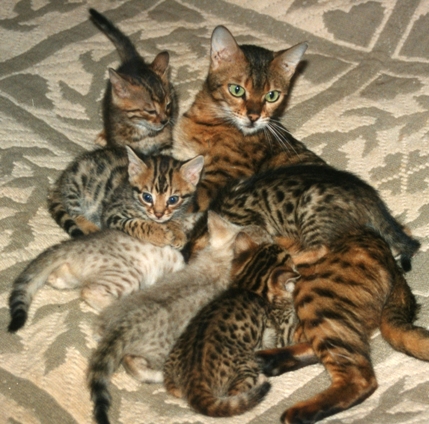
Some say that due to their ancestry, Bengals are inherently more prone to parasites than other breeds, but we haven’t noticed this in ours. However, all kittens must be wormed regularly for both tapeworms and roundworms and their owners should speak to their vet if they’re unsure what to use. We use Drontal tablets or Spot-on neck liquid. And the best flea products are the injection, or Stronghold or Frontline (both are liquids that are applied to the kitten’s neck).
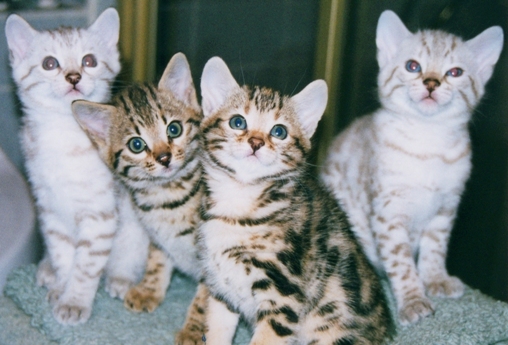 We
also strongly advise insuring all
Bengals as vet’s bills can be huge if a problem occurs! Micro
chipping is also a
superb idea. And kittens must be neutered unless the owner wishes to
breed - the males at 5 months old or they may spray, and females at 6
months.
We
also strongly advise insuring all
Bengals as vet’s bills can be huge if a problem occurs! Micro
chipping is also a
superb idea. And kittens must be neutered unless the owner wishes to
breed - the males at 5 months old or they may spray, and females at 6
months.
Sarez
Ramani, Honey Bee, Anjali, Mallika (Left to Right - F2s) - Circa
Oct. 2001
Bengal cats make loyal and fun companions. But it is the environment in which the breeder rears them, and then the one that their new owners provide for the kitten, that determines their adult character… just as a child’s upbringing creates their adult personality. So the prospective owners should choose well, and then treat their new kitten in the same way they would a child - because these animals live, feel and love in a similar way to them.
Adding a Bengal to one’s family is a life changing experience, and those who embark upon this adventure should cherish every precious moment of it…
C. Esmond Gay
Sarez Bengals
Copyright 2004 C. Esmond Gay
Dedicated to all our kittens
Retirement Addition (2008)
Sarah and I achieved a phenomenal amount during the 11 years that we bred Bengals and many of our accomplishments are still unsurpassed. We obsessively chased every one of our goals and ambitions and didn’t stop until we had succeeded. And everything we did was meticulous and done to perfectionist standards.
However, this entailed working up to 18 hours a day, 7 days a week, and with few breaks or holidays. In hindsight, we did too much too fast because the enormous stress that we put ourselves under, plus looking after hundreds of animals almost single-handedly, took its toll on us mentally, emotionally and physically. By 2004, Sarah and I were suffering from severe exhaustion and so reluctantly, we retired. We hoped to lead a quieter life in Latin America, living and working with their endangered cats.
Our larger wild felines went to wildlife parks, our rescued animals went to sanctuaries and private homes, whilst many of our Bengals and leopard cats went to Pauline and Frank Turnock of Gayzette Bengals - they look after and nurture our cats, and are expanding the breeding programme that we worked so hard to create.
I stay in regular contact with Pauline and Frank and offer them my support and advice on the Bengal and wild cats. I follow their achievements, and behind the scenes, I am there for them and for the beautiful cats that we once so proudly owned.
To
Sarah and me, our cats were more than just pets or breeding animals -
they were our family. And within the articles I wrote, my deeply
emotional descriptions of them and how they influenced our lives,
portrays just how powerfully I love them; and so naturally, I feel
terrible loss and miss them tremendously. However, I am grateful for
the 11 wonderful years that they graced our home, and for the honour
and privilege of being able to share part of my life with them…
and
for the amazing memories that they’ve left me with.
C. Esmond Gay




